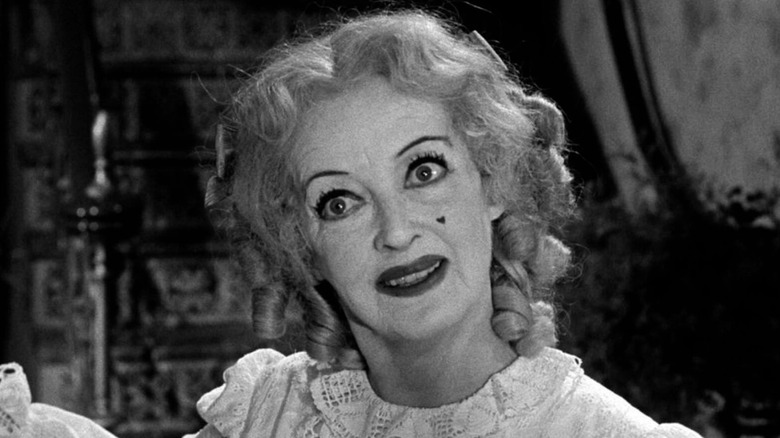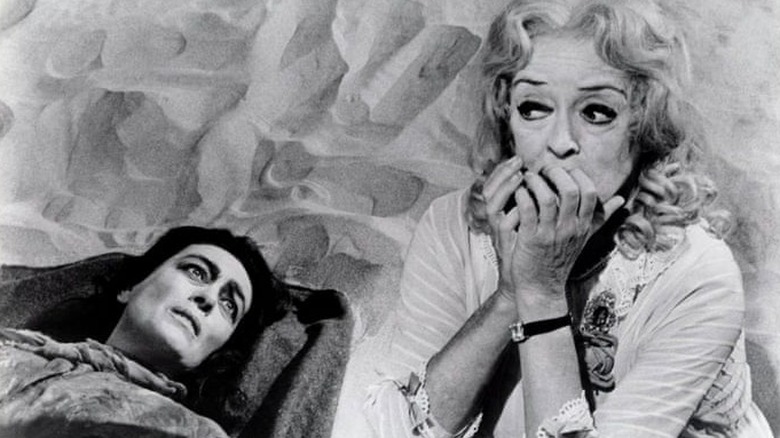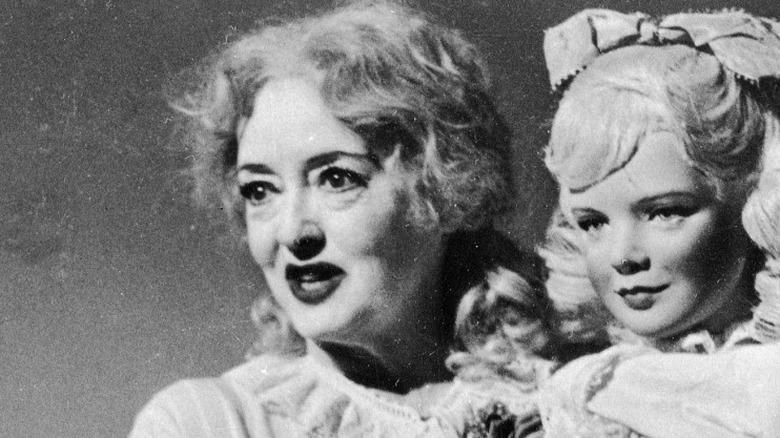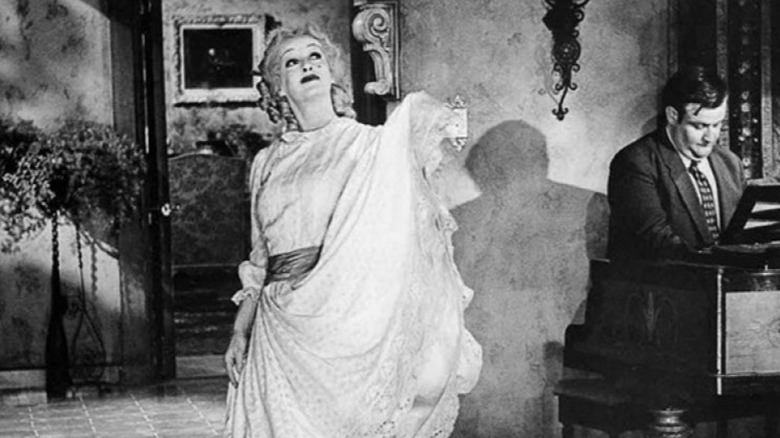
As much as Robert Aldrich's 1962 film "What Ever Happened To Baby Jane?" became a camp classic for its wild twists, shrieking old women, and creepy makeup, its tragic power can't be denied. There's a grand scope to the movie, even though so much of it takes place in the glamorous but suffocating home of its two leading ladies. Some of that scope comes from the prologue, which takes viewers as far back as 1917 — but it also comes from the movie's reckoning with Hollywood history, in the ways stars were treated, in the venomous effects of celebrity on the soul, and in the use of Joan Crawford and Bette Davis as the clashing sisters at its center.
Of course, Crawford and Davis had a legendary feud going back decades, one so well-known in Hollywood lore that it (and the production of "Baby Jane") became the subject of Ryan Murphy's miniseries "Feud," where Aldrich was played by Alfred Molina. They would duel over roles, cast barbs at each other via the press, and when one sought to make things right, the other would refuse. Rinse and repeat.
By the early '60s, they were both older, with years having passed since the heights of their stardom. Peace did not come with age, nor did it come with the actresses losing favor with the general public, and "Baby Jane" would become a stage for the latest iteration of their feud. Naturally, part of the movie's reputation is that it's a big Bette vs. Joan showcase, with both actresses vying to overshadow the other.
If it was a fight, Davis had a plan to win. It would involve her makeup.
Bette And Joan

"What Ever Happened To Baby Jane?" is a perfect title for a movie about movie stars who have been largely forgotten. These two stars, the Hudson sisters Jane (Bette Davis) and Blanche (Joan Crawford), had far different times in Hollywood. Jane had risen to stardom as a spoiled child performer in 1917. Blanche became a star in Depression-era Hollywood, whose major box office draw meant that studios had to listen to her when she begged them to give her sister roles. For the favor, Jane runs her over in a drunken rage, paralyzing Blanche and committing both of them to a painful, suffocating 30 years together.
While Bette Davis and Joan Crawford shared many similar qualities — so much so that they were often fighting for the same roles when they both worked at Warner Bros. — there was one major difference, one whose narrative Davis especially pushed. In Davis' eyes, it all came down to her willingness to be a genuine actor, not vain in the way movie stars (particularly as she referred to Crawford) tended to be. She was willing to be ugly, deranged, lustful, passionate, whatever the role required, and "What Ever Happened To Baby Jane?" would require a major leap from her.
Meanwhile, as Davis put it in her 1987 memoir "This 'n' That," Crawford refused to "not look gorgeous" while making the movie. As Davis perceived it, that was a betrayal of the characters and what they should look like, and of the haunting tragedy at the movie's center.
Davis' idea for what Jane should look like would be shocking to the viewers, and it became immediately controversial to the filmmakers. As Ron Howard would learn some 20 years later, Davis was a force to be reckoned with, and directors crossed her at their own peril.
Vanity

What did the older Baby Jane look like? As Roger Ebert put it in his retrospective review of "What Ever Happened To Baby Jane?," "no one who has seen the film will ever forget her."
When we first hear of her, it's in the sisters' neighbors' gossip as they watch some old Blanche Hudson movies on television, chatting about the great movie star while a dog food ad plays. The daughter (played by Bette Davis' real-life daughter B.D. Hyman, whose controversial memoir of her mother's abusive behavior got her disinherited) complains that nobody sees Blanche, who is more or less locked in the attic, and complains about Jane's appearance.
Jane makes an impression. Far from the cute, tap-dancing kid in the movie's prologue, and certainly far from memories of classic Bette Davis, Jane Hudson is quite grotesque, with big curly hair imported from the early 20th century and heavy layers of pancake makeup and thick lines of eyeshadow. She looks not dissimilar from the life-size Baby Jane doll she sings to in her kitchen. Except, of course, that she's a real person, who beneath the uncanny makeup is getting older every day — a fact she reacts to with rage.
As unforgettable as Jane's look is, particularly with the movie's high-contrast horror lighting, it was not necessarily something the studio wanted. It was actually Davis' idea, reflecting her feeling that she wasn't acting out of vanity. To her, this was the truest place to take the character. In much the same way "All About Eve" was changed to accommodate Davis' casting, "Baby Jane" would be conceded to Davis' ideas, for the better.
Fighting For The Look

Part of Bette Davis' notion of what Jane Hudson should look like came from what she saw in the wild: older women who existed on the fringes of Hollywood and, by the '50s and '60s, still wore makeup with the intention of looking young. Because of that, the image is almost a cruel parody of real-life figures who haunted Hollywood streets. As Davis said in "This 'n' That," she presumed "by the way they looked they were once actresses, and were now unemployed."
So she got to work on the look of the character, coming up with something that she felt no professional makeup artist would want to do. She knew the risk of looking like this, and how it could irrevocably color the public's idea of her. By just a couple days into the production, producer and director Robert Aldrich was getting cold feet over her appearance, thinking it was "laughable." So Davis gave him an ultimatum, saying she would refuse to play the movie unless she could wear the makeup.
Aldrich relented. Seeing the rushes for the movie, he noted that he "got used to" the makeup. Baby Jane, famed for her childlike blond curls and beauty mark and heavy layers of powdered makeup, became an iconic movie villain, as well-known for her scenes of pathetic narcissism as for her "outrageous" appearance.
If the movie was a battleground for Joan Crawford and Bette Davis, it's hard not to see that Davis won, considering how memorable and grotesque her character is. Even though neither Crawford nor Davis was considered "bankable" enough to make the movie by 1962, the rivalry burned brighter after the success of this film, and especially after the lengths Davis was willing to go.
Read this next: 15 Best Movies Of The 1960s, Ranked
The post Bette Davis Went To War Over Her Makeup For What Ever Happened To Baby Jane appeared first on /Film.
0 Comments